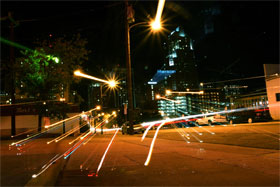
Global innovation firm Frog Design recently brought designers, futurists and journalists together to envision the future of computing in 2020. In 2020, the computer is not only incorporated into every aspect of our lives, but should become an integral part of ourselves. With this in mind, the workshop aimed to imagine how future technology would influence the key areas of Social, Travel, Commerce, Healthcare, and Media.
In the “Bodynet” concept scenario, future technologies will monitor our body’s vital conditions and compute the outcome of our actions on-the-fly. So this technology allows you to enjoy that McDonalds meal even more, being assured by a floating data dashboard how it will shorten your estimated lifespan with several weeks.
The “Whuffie Meter” merges your physical presence with that of your online social identity. Socializing will take on completely new dimensions when people can see everything public about a person on semi-transparent infographic displays floating over their heads, right as they are talking with them. Question of allowing people to map your faked personal ad information to your person straight away.
“ThingBook” exploits the concept of “Internet of Things” to allow people to go shopping practically everywhere and at any time. Do you like that new car you saw drive by? Just call up the floating interface and press “buy”. Want to really know how old that shirt is of your work colleague? Discover and humiliate him right there and then.
More information at Pattern Language blog and Forbes.
Filed under: Uncategorized





 At the
At the  Google executives are wrestling over whether to launch controversial facial recognition technology after a barrage of criticism over its privacy policies. The
Google executives are wrestling over whether to launch controversial facial recognition technology after a barrage of criticism over its privacy policies. The  LocativeLab.org is Ronald Lenz's research website on locative & mobile media. This is mostly an archive of blogposts I find inspiring and interesting and an
LocativeLab.org is Ronald Lenz's research website on locative & mobile media. This is mostly an archive of blogposts I find inspiring and interesting and an  Find me at
Find me at